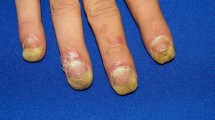Abstract
Background
Nail psoriasis is a common problem in psoriatic patients and often it is difficult to cure. Several treatments have been proposed in the last decade using new molecules like vitamin-D analog and/or immunosoppressive drugs both systemically and locally.
Objective
Our goal was to evaluate a combination of cyclosporin and topical calcipotriol cream versus cyclosporin alone in a matched group of patients treated with cyclosporin alone.
Méthod
Fifty-four patients affected by severe psoriasis and nail involvement were selected and matched for severity of nail involvement, sex, age, and cyclosporin dosage. Group A included 21 patients treated with cyclosporin alone (3.5 mg/kg/day) for three months. Group B included 33 patients treated with the same cyclosporin dosage plus, for the same time, topical application of calcipotriol cream twice a day. Evaluation for clinical improvement was the personal feeling of the patient after three months, while clinical appearance of the lesions was evaluated by the same dermatologist using digital pictures and who was blind as to the treatment of the patient. A score ranging from + to +++ was used in order to evaluate the improvement, and data were statistically evaluated with the Wilcoxon test.
Results
Both cyclosporin alone and a combination of cyclosporin with topical calcipotriol twice a day were useful for treating nail psoriasis after three months of therapy although the combined therapy showed a better overall result in both mild and severe nail psoriasis. Improvement of the clinical appearance of the nail lesions was seen in about 79% of patients in group B (p ≤ 0.0004) versus about 47% of patients in group A (p ≤ 0.15).
Conclusions
In patients with severe involvement of nail psoriasis we suggest the use of a combination of topical calcipotriol twice a day with systemic treatment such as cyclosporine.
Sommaire
Antécédents
Le psoriasis unguéal est une affection fréquente et souvent difficile à guérir qui se présente chez les patients souffrant de psoriasis. Plusieurs traitements ont été proposés durant la dernière décennie qui impliquent I’usage systémique ou local de nouvelles molécules telles que l’analogue de la vitamine D ou des médicaments immunosuppresseurs.
Objectif
Notre objectif était de comparer l’effet d’un traitement combiné de la cyclosporine et du calcipotriol topique en crème avec l’effet de la cyclosporine utilisée seule, dans un groupe apparetllé de patients traités à la cyclosporine.
Method
54 patients souffrant de psoriasis aigu impliquant l’ongle ont été choisis et appareillés selon la gravité de l’atteinte, le sexe, 1’âge et le dosage de cyclosporine. Le groupe A comprenait 21 patients traités à la cyclosporine seule (3,5 mg/kg/jour) pendant trois (3) mois; le groupe B comptait 33 patients traités à la même dose de cyclosporine mais recevant en plus, et pendant la même durée, une application topique de calcipotriol en crème deux fois par jour. L’amélioration clinique était évaluée selon le sens de soulagement personnel des patients après 3 mois. L’apparence clinique des lésions était évaluée au moyen de photos numériques prises par un dermatologue ne connaissant pas la nature du traitement des patients. Un score variant entre + et +++ a été utilisé en vue d’évaluer l’amélioration; l’évaluation statistique des données a été faite au moyen du test de Wilcoxon.
Résultats
Le traitement systémique utilisant la cyclosporine seule ou une combinaison de cyclosporine et de calcipotriol topique deux fois par jour ont été efficaces dans le traitement du psoriasis unguéal après trois mois de thérapie. Cependant, le traitement combiné a donné de meilleurs résultats généraux dans les cas de psoriasis unguéal moyen et grave. Une amélioration de l’apparence clinique des lésions de l’ongle a été remarquée chez 79% des patients du groupe B (p ≤ 0.0004) comparativement à environ 47% chez les patients du groupe A, soil le groupe traité à la cyclosporine seule (p ≤ 0.15).
Conclusion
Chez les patients atteints d’un psoriasis unguéal grave, nous recommandons un traitement combinant le calcipotriol topique, deux fois par jour, à un traitement systémique, la cyclosporine par exemple.

Similar content being viewed by others
References
F Gueissaz L Borradori L Dubertret (1992) ArticleTitlePsoriasis unguéal. Ann Dermatol Venereol 119 57–63 Occurrence Handle1:STN:280:By2B383it1Y%3D Occurrence Handle1562156
GE Piérard C Piérard–Franchimont (1996) ArticleTitleDynamics of psoriatic trachyonychia during low-dose cyclosporin A treatment: a pilot study on onychochronobiology using optical profilometry. Dermatology 192 116–119 Occurrence Handle8829491
WP Arnold MJ Gerritsen PC VandeKerkhof (1993) ArticleTitleResponse of nail psoriasis to cyclosporin. Br J Dermatol 129 750–751 Occurrence Handle1:STN:280:ByuC3MvktFA%3D Occurrence Handle8286269
W Petrow (1995) ArticleTitleCalcipotriol: ein topisches therapeutikum zur behandlung der nagelpsoriasis. Akt Dermatol 21 396–400
F Kokelj G Lavaroni BM Piraccini et al. (1994) ArticleTitleNail psoriasis treated with Calcipotriol (MC 903): an open study. J. Dermatol Treat 5 149–150
Author information
Authors and Affiliations
Corresponding author
About this article
Cite this article
Feliciani, C., Zampetti, A., Forleo, P. et al. Nail Psoriasis: Combined Therapy with Systemic Cyclosporin and Topical Calcipotriol . JCMS 8, 122–125 (2004). https://doi.org/10.1007/s10227-004-0114-8
Published:
Issue Date:
DOI: https://doi.org/10.1007/s10227-004-0114-8




